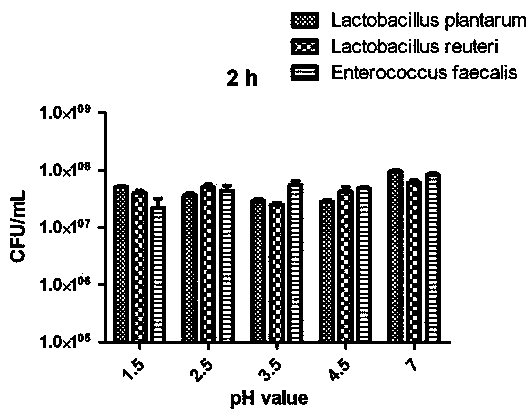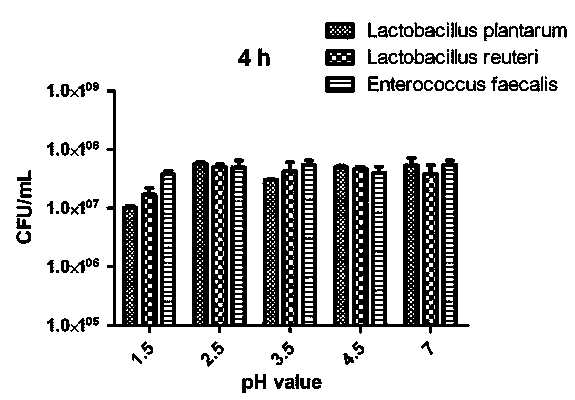Method for screening live pig intestinal micro-ecological preparation with high adhesive capacity
A micro-ecological preparation and high-adhesion technology, applied in the direction of microorganism-based methods, biochemical equipment and methods, microorganisms, etc., can solve problems such as drug residues, affecting meat quality, flavor and food safety, and achieve simple methods , highly targeted effect
- Summary
- Abstract
- Description
- Claims
- Application Information
AI Technical Summary
Problems solved by technology
Method used
Image
Examples
Embodiment 1
[0019] Screening and identification of strongly adherent bacteria in pig feces:
[0020] 1. Collection and preservation of samples: collect feces and intestinal wall mucosal layer substances in the cecum of healthy pigs, transfer them to anaerobic environment, add glycerin, whose weight is 10% of the total weight of feces and glycerin, mix well with a vortex shaker, - Store at 8O ℃;
[0021] 2. Assembly and use of the chemostat: connect the storage tank, fermentation tank, waste liquid tank, rubber plug, silicone tube, glass bottle containing NaOH and ventilation filter in order, place them on the workbench, connect and mix Gas, peristaltic pump, pH regulator, magnetic stirrer, exhaust gas removal device;
[0022] 3. Preparation of culture medium in the chemostat: add the following ingredients according to the mass percentage of the added ingredients in the final product: 5‰ soluble starch, 3‰ bovine casein, 3‰ peptone, 0.6‰ pectin, 0.6‰ xylan, 0.6 ‰ Arabinogalactan, 0.6‰ Pu...
Embodiment 2
[0024] Embodiment 2: the identification of screening bacterial strain
[0025] Scrape the material on the wall of the chemostat bottle, use the viable count method to isolate the microorganism and send it to the sequencing company for identification. The identification results are shown in Table 1. A total of 3 microorganisms were isolated, which are Lactobacillus plantarum WCFS1Lactobacillus plantarum, and the gene sequence number It is NR_076229.1; Lactobacillus reuteri, whose gene sequence number is EF421935.1; Enterococcus faecalis, whose gene sequence number is AY735444.1. The above three kinds of probiotics can be obtained from public institutions such as, and their gene sequences can be obtained from the public database NCBI.
Embodiment 3
[0026] Example 3: Evaluation of probiotic properties of screening strains
[0027] 1. Determination of adhesion strength: HT-29 cells were cultured in 1640 medium with 10% fetal bovine serum, and after confluence, the three kinds of bacteria selected were added Lactobacillus plantarum, Lactobacillus reuteri, Enterococcus faecalis , calculate the number of bacteria per 100 cells after culturing for 2 hours;
[0028] 3. Determination of acid-base tolerance: prepare MRS medium, set the pH to five gradients of 1.5, 2.5, 3.5, 4.5, and 7.0, inoculate 1% of the three bacterial solutions respectively, and count the viable bacteria after overnight culture;
[0029] 4. Bile salt tolerance test: Prepare MRS medium, set the bile salt concentration to four gradients of 0, 0.10%, 0.30%, and 0.50%, inoculate 1% of the three bacterial solutions respectively, and count the viable bacteria after overnight culture.
[0030] 5. The results of the determination of intestinal microbial adhesion ...
PUM
 Login to View More
Login to View More Abstract
Description
Claims
Application Information
 Login to View More
Login to View More - R&D Engineer
- R&D Manager
- IP Professional
- Industry Leading Data Capabilities
- Powerful AI technology
- Patent DNA Extraction
Browse by: Latest US Patents, China's latest patents, Technical Efficacy Thesaurus, Application Domain, Technology Topic, Popular Technical Reports.
© 2024 PatSnap. All rights reserved.Legal|Privacy policy|Modern Slavery Act Transparency Statement|Sitemap|About US| Contact US: help@patsnap.com










